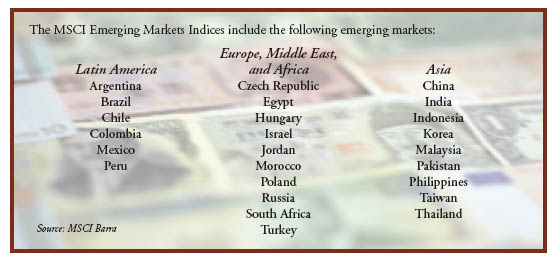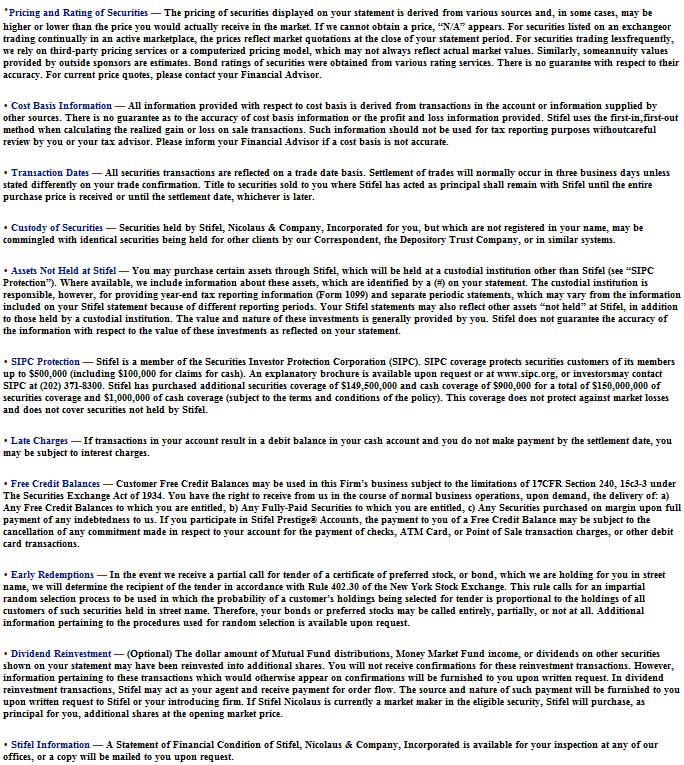|
ROLLOVER
CENTER |
| |
|
| |
STIFEL NICOLAUS |
| |
|
|
Investment StrategistTM
International Investments:
A Key Component to Any Portfolio
June 2008
Increased globalization
has resulted in widespread economic growth throughout the world. In
today�s global economy, U.S. companies have expanded their reach to
serve a growing international client base. At the same time, more and
more of the products and services we use every day come from companies
that are based overseas.
As foreign economies
continue to expand, one way to potentially take part in their growth
is through international investing. While diversification does not
ensure against loss, diversification is key to any successful asset
allocation plan, and investing in foreign stocks offers a great way
for investors to round out a balanced portfolio. Foreign markets
generally lack correlation with our own stock market, meaning that
when one is down the other may be up. This can help counterbalance the
impact of fluctuations in the value of U.S. stocks in your portfolio
by spreading the risk.
Despite their many
strengths, foreign stocks are lacking in many investors� portfolios �
either due to lack of knowledge about foreign markets or apprehension
about the potential volatility involved. However, those who are
willing to perform the research necessary to make informed investment
decisions can potentially reap the rewards of taking on the risks of
international investing.
The Risks of
Foreign Investing
While international stocks
offer potential rewards, they also present many different forms of
risk, above and beyond those of domestic investments. These additional
risks make it critical that you do your homework and have a full
understanding of your own tolerance for risk before making foreign
investments.
Currency Risk
� International stocks are priced in the currencies of their home
markets. As such, their value to U.S. investors is affected by the
relative strength or weakness of the U.S. dollar. When the value of
the U.S. dollar is weaker, the value of foreign assets owned by U.S.
investors increases. A stronger U.S. dollar has an inverse effect,
lessening the value of foreign assets owned by U.S. investors.
Investors can potentially limit currency risk by holding their
investments over a longer period of time, as changes in the value of
the dollar tend to even out over time.
Country Risk
� The financial markets in some countries are
more volatile than others due to a variety of factors, such as
political instability, financial policies, war, natural disasters,
etc. The risk involved in investing in emerging markets (see below)
tends to be greater than that of more established markets.
Liquidity Risk
� The stock markets of developed
countries such as the United States and Great Britain are among the
most sophisticated in the world, allowing investors to make nearly
instantaneous transactions and receive up-to-the-minute information.
Not all financial markets, however, are this efficient. In developing
markets, extra care and consideration must be taken to help ensure
that transactions are processed in a timely manner.
Lack of Information � In the
U.S., publicly held companies are required to disclose their financial
performance and investors have access to a wide range of data for
research purposes. Other countries are not as stringent, making it
difficult to perform an analysis of a firm�s financial health.

V i s i o n
� P l a n n i n g
�
Focus
SNINS050801 |
|
|
|
International
Investments: A Key Component to Any Portfolio (continued) |
|
|
|
|
|
Selected International Indices vs.
the S&P 500 |
|
Calendar Year
Returns (Year-to-date figures are as of March 31, 2008) |
| |
YTD |
2007 |
2006 |
2005 |
2004 |
|
MSCI World Index |
-8.94% |
9.57% |
20.65% |
10.02% |
15.25% |
|
MSCI World Ex. U.S. Index |
-8.60% |
12.91% |
26.23% |
14.95% |
20.84% |
|
MSCI EM Latin America Index |
-1.39% |
50.67% |
43.48% |
50.42% |
39.62% |
|
MSCI EM Europe, Middle East, and
Africa Index |
-12.13% |
31.62% |
26.74% |
45.19% |
31.48% |
|
MSCI EM Asia Index |
-14.11% |
41.58% |
33.22% |
27.50% |
15.33% |
|
S&P 500 Index |
-9.44% |
5.49% |
15.79% |
4.91% |
10.88% |
|
Created with Zephyr StyleADVISOR. Returns assume reinvestment of
dividends but do not take into consideration fees, expenses, or
taxes. Past performance is not indicative of future results. The
MSCI World Index is designed to measure the equity market
performance of 23 developed markets in North America, Europe, and
the Pacific. The MSCI World Ex. U.S. Index is designed to measure
the equity market performance of 22 developed markets in North
America (excluding the United States), Europe, and the Pacific.
The MSCI EM (Emerging Markets) Latin America Index is designed to
measure the equity market performance of 6 emerging market country
indices in Latin America. The MSCI EM (Emerging Markets) Europe,
Middle East, and Africa Index is designed to measure the equity
market performance of 10 emerging market country indices of
Europe, the Middle East, and Africa. The MSCI EM (Emerging
Markets) Asia Index is designed to measure the equity market
performance of 9 emerging market country indices of Asia.The S&P
500 Index is generally considered representative of the U.S. large
capitalization market. Indices are capitalization-weighted,
unmanaged, and not available for direct investment. The
performance shown is for illustrative purposes only and is not
indicative of the performance of any specific investment.
|
|
|
|
Ways to Invest
There are several different ways to invest
in foreign securities, each offering certain advantages and differing
levels of complexity.
Individual Securities
� Shares of overseas companies that are not
available through an American market can be purchased on foreign
exchanges. These trades can be more expensive while possibly offering
less liquidity than a typical domestic trade, adding an extra layer of
complexity to the transaction.
American Depositary
Receipts � American depositary receipts
(ADRs) alleviate the need to purchase stocks on a foreign exchange,
giving investors easy access to international markets. ADRs can be
found listed on the New York Stock Exchange, the Nasdaq, and other
domestic stock exchanges and are bought and sold just like shares of
U.S.-based companies. And just like U.S.-based companies, foreign
companies with ADRs issue financial reports in conformance with SEC
regulations. Many major foreign companies offer ADRs.
Mutual Funds � Mutual
funds are a convenient way to invest in foreign markets, and many
mutual fund providers currently offer either actively managed
international funds or passively managed funds that seek to match the
returns of a specific international stock market index, such as the
Japanese Nikkei or the British FTSE.
While actively managed
mutual funds do not alleviate risk, the major advantage that they
offer is their simplicity, as a professional fund manager undertakes
the burden of selecting stocks and addressing the various risks
associated with international investing.
Mutual funds holding
foreign stocks can be broken down into four basic categories: global,
international, regional, and country.
Global Funds
� Hold stocks in companies all
over the world, including both U.S.-based stocks and foreign stocks.
International Funds � Invest solely
in the securities of companies based outside of the U.S.
Regional Funds � These funds focus on
a specific geographical region, such as Asia, offering diversification
by investing in multiple countries in the selected region.
Country Funds � Invest entirely in
securities issued by a single country.
Investors should
consider a fund�s investment objective, risks, charges, and expenses
carefully before investing. The prospectus, which contains this and
other important information, is available from your Financial Advisor
and should be read carefully before investing. The investment return
and principal value of an investment will fluctuate, so that an
investor�s shares, when redeemed, may be worth more or less than their
original cost.

Exchange Traded Funds � Similar to
index mutual funds, exchange traded funds (ETFs) seek to match the
returns of a specific stock market index. ETFs are bought and sold
just like stocks and typically offer lower fees than index funds. Both
are passively managed and experience low portfolio turnover. Tax
efficiency is also a key characteristic of both ETFs and index funds.
The main difference between the two lies in pricing. Index funds are
re-priced at the end of each trading day, while ETFs are priced
throughout the day, similar to stocks. They can also be sold short or
bought on margin. ETFs may also be especially attractive to investors
who wish to track a particular index for which there is no index fund
available. While ETFs do not charge sales loads, the purchase and sale
of ETF shares are subject to ordinary brokerage commissions.
Exchange Traded Funds
(ETFs) represent a share of all of the stocks in their respective
index held in a trust. Therefore, ETFs are subject to market risk,
including the possible loss of principal. The value of the portfolio
will fluctuate with the value of the underlying securities.
Investors should
consider an ETF�s investment objective, risks, charges, and expenses
carefully before investing. The prospectus, which contains this and
other important information, is available from your Financial Advisor
and should be read carefully before investing.
A Note on Emerging Markets
Further down the risk-reward spectrum are
emerging markets. While there is no overarching definition of an
emerging market, they are generally identified as possessing the
following characteristics:
Greater potential for political instability
Increased currency volatility
Lower per capita income
Countries falling into the category of emerging markets include
such economic powerhouses as China and India, as well as smaller
countries such as the Philippines. While emerging markets are
considered to be more volatile than their more highly developed
counterparts, their potential for growth is higher as well.

Getting Started in International
Investing
Your Stifel
Financial Advisor can introduce you to the wide variety of
international investments available to you and the role that they can
play in your portfolio. The percentage of foreign stocks that you
should have in your portfolio is entirely contingent on your unique
financial situation and your own personal tolerance for risk.
To better understand the
risks in your investments and discuss strategies for managing risk,
talk to your Financial Advisor today. The Asset Allocation Analysis
Report, through the Stifel PACT�
Program, can help you ascertain your tolerance for risk and develop an
asset allocation consistent with your needs and risk tolerance.


 Stifel, Nicolaus & Company, Incorporated
� Member SIPC and New York
Stock Exchange
� One
Financial Plaza, 501 North Broadway, St. Louis, Missouri 63102
� www.stifel.com
|
|
|

